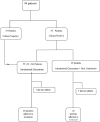Bacterial contamination in cutaneous leishmaniasis: its effect on the lesions' healing course
- PMID: 25814725
- PMCID: PMC4372929
- DOI: 10.4103/0019-5154.152560
Bacterial contamination in cutaneous leishmaniasis: its effect on the lesions' healing course
Abstract
Background: The colonization of aerobic and anaerobic microbial agents on cutaneous leishmaniasis (CL) lesions, especially acute erosive ulcerative ones, has been mentioned in previous studies showing controversial results on the healing course of lesions with the use of antibiotics.
Aims: The purpose of this study was to evaluate the prevalence of secondary bacterial infections in CL lesions and the effect of its elimination on the lesions' improvement rate.
Materials and methods: This cross-sectional clinical trial was performed on 84 acute CL patients. The required skin samples were taken. Cultivation for bacteria was conducted. Patients with positive culture results were divided into two groups. Both groups received standard anti-leishmania treatment, whereas only one group was treated with cephalexin 40-50 mg/kg/day for 10 days. The improvement rate was evaluated in the following visits based on changes in the lesions' induration size.
Results: Among the 84 studied patients, 22.6% had a negative culture result whereas the result was positive in 77.4%. The most common pathogenic germs were Staphylococcus aureus (52.3%) and Staphylococcus epidermidis (9.5%); 34/5% of the positive lesions received antibiotic treatment. Finally, among the lesions with a 75-100% improvement rate, no significant difference was observed between the antibiotic-treated and -untreated groups (36.1% vs. 63.9%, respectively, P = 0.403).
Conclusions: The most common pathogen was S. aureus and, as a primary outcome, the simultaneous treatment for microbial agents did not have any considerable effect on the improvement rate of CL lesions.
Keywords: Acute cutaneous leishmaniasis; aerobe; anaerobe; antibiotic; bacterial colonization.
Conflict of interest statement
Figures
References
-
- Klaus SN, Frankenburg S, Ingber A. Epidemiology of cutaneous leishmaniasis. Clin Dermatol. 1999;17:257–60. - PubMed
-
- Layegh P, Yazdanpanah MJ, Vosugh EM, Pezeshkpoor F, Shakeri MT, Moghiman T. Efficacy of azithromycin versus systemic meglumine antimoniate (Glucantime) in the treatment of cutaneous leishmaniasis. Am J Trop Med Hyg. 2007;77:99–101. - PubMed
-
- AlSamarai AM, AlObaidi HS. Cutaneous leishmaniasis in Iraq. J Infect Dev Ctries. 2009;3:123–9. - PubMed
-
- Shirazi MH, Ranjbar R, Asgari V, Mohebali M, Hamidian M. Study of bacterial infections among the patients with suspected cutaneous leishmaniasis. Pak J Biol Sci. 2007;10:4555–8. - PubMed
LinkOut - more resources
Full Text Sources


